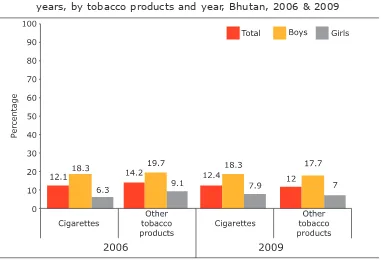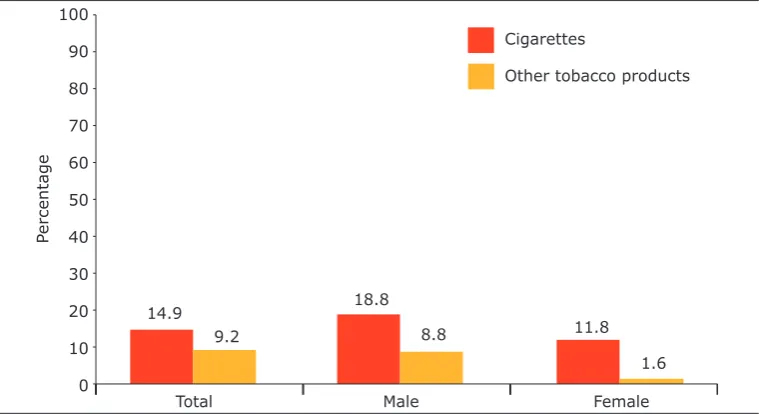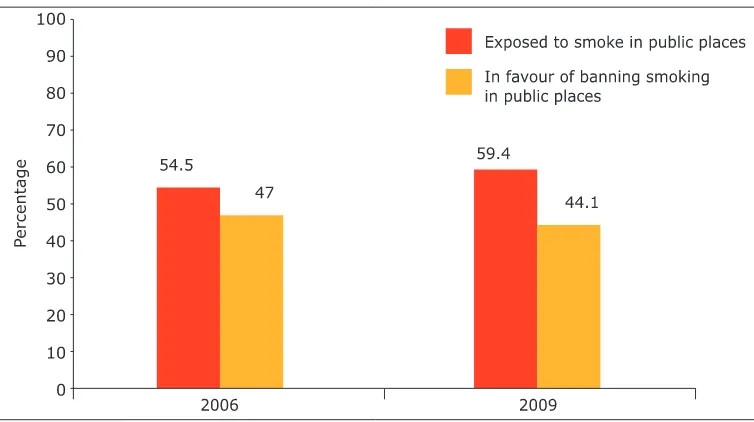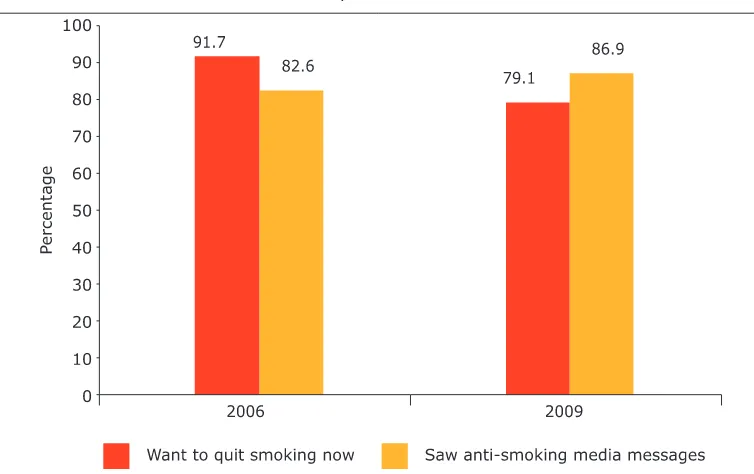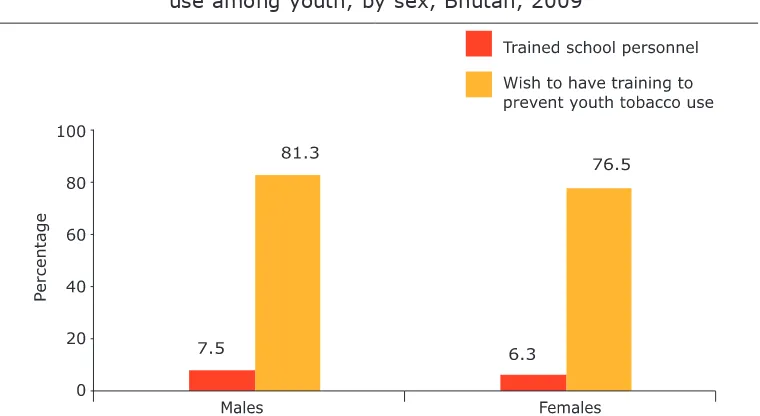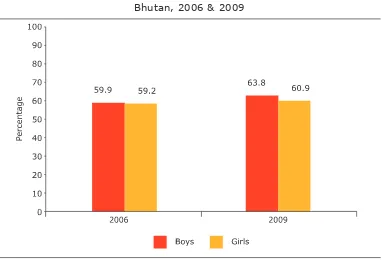Tobacco Control in Bhutan
Royal Government of Bhutan
Contents
Foreword v
General information about Bhutan 1
Tobacco use in Bhutan 2
Tobacco Control in Bhutan 3
Bhutan and the global tobacco surveillance system 5
MPOWER policy package in Bhutan 7
Conclusion 16
Foreword
Diseases caused by tobacco use have profound implications on the quality of life of individuals, families and societies at large. Control of tobacco consumption, therefore, represents a major public health challenge for Bhutan. It gives me immense pleasure to note the release of the document
Brief Proile on Tobacco Control in Bhutan which provides the state-of-affairs and suggests a road map for tobacco control in the country.
The series of Global Youth Tobacco Survey (GYTS) and Global School Personnel Survey (GSPS) conducted in the country highlight a very serious concern. I am particularly drawn by the fact that prevalence of tobacco use among students in the country is higher than the regional average. These evidences highlight the need for a proactive and sustained tobacco control initiatives in the country particularly targeted among youth and children. It also highlights the need to involve teachers and parents as role models and agents of change.
This document, which contains data from the GYTS and GSPS surveys, would provide an important platform to base policy measures and guide suitable interventions and strategies for Bhutan’s Tobacco Free initiative. It also provides the baseline measures for monitoring and evaluation of tobacco control initiatives towards, ultimately, achieving the goals outlined in the Framework Convention on Tobacco Control. The evidences and suggestions in the report need to be widely disseminated among school teachers and students and all other stakeholders to bring about awareness regarding serious and adverse health impact of tobacco.
I would like to thank all those who were involved in bringing up this document. I am particularly grateful to the World Health Organization and the Centre for Disease Control for helping us generate crucial evidence through various surveys. With the enactment of the Tobacco Control Act of Bhutan 2010 and the indings of these surveys, we hope we will be able to make Bhutan a Tobacco-Free country and enables its people to live healthier and happier lives.
Zangley Dupka Minister
Ministry of Health
General information
about Bhutan
The Kingdom of Bhutan is a landlocked country situated on the lap of the
eastern and bordered to the south, east and west by the Republic of India
and to the north by the People’s Republic of China. Bhutan is separated from
the neighbouring state of Nepal in the west by the Indian state of Sikkim, and from Bangladesh in the south by the state of West Bengal in India.
The population of Bhutan as per the July 2009 estimate is 691 141. The population growth rate (average annual percentage growth) for 2005–2010 is 1.7%.
Bhutan’s gross domestic product (GDP) for 2009 was estimated at US$
1.269 billion (adjusted to nominal GDP). Bhutan has balanced modernization
with its ancient culture and traditions under the guiding and overriding inclusive philosophy of Gross National Happiness (GNH). Agriculture provides
2 Brief Proile of Tobacco Control in Bhutan
Tobacco use in Bhutan
Bhutan has no scientiic data on adult tobacco use but the indings from the Global Youth Tobacco Survey (GYTS) and the Global School Personnel Survey (GSPS) indicate that tobacco use among students aged 13-15 and school personnel is high.
Tobacco control in Bhutan
The WHO Framework Convention on Tobacco
Control (WHO FCTC) and Bhutan
Bhutan signed the WHO Framework Convention on Tobacco Control
on 9 December 2003.
Bhutan ratiied the WHO Framework Convention on Tobacco Control
on 23 August 2004.
Tobacco Control Act of Bhutan 2010
The Tobacco Control legislation had been developed in line with the WHO Framework Convention on Tobacco Controland was enacted by the Parliament of Bhutan on 6th June 2010.
Tobacco control efforts
Bhutan is unique in its tobacco control efforts. The cultivation,
harvest, manufacture, supply, distribution and sale of tobacco products is banned in the country.
A National Steering Committee on Tobacco Control has been formed
with representation from all sectors concerned to coordinate and guide the implementation of all tobacco control activities. The National Steering Committee on Tobacco Control has recommended that demand reduction should be given the major emphasis in terms of tobacco control.
There is a ban on the sale of tobacco products throughout the country
with effect from 17 December 2004 (based on the resolution ma-7 of the 82nd National Assembly of Bhutan).
Smoking is prohibited in public places by an Executive order. Two
notiications to this effect were brought out on 8 November 2004 and 18 February 2005. Smoke-free areas were declared through these notiications with effect from 1 March 2005, and the penalties for violation of the notiication have been earmarked. The Royal Bhutan Police has been empowered to enforce and monitor the implementation of smoke-free areas.
Advertising of tobacco products on all the national media channels
4 Brief Proile of Tobacco Control in Bhutan
World No-Tobacco Day (WNTD) has been regularly observed with
various activities.
Advocacy of the MPOWER policy package among health personnel,
relevant partners, stakeholders, ministries and institutions has been initiated.
B h u t a n h a s b e e n cooperating with regional and global tobacco control networks in the transfer of technical, scientiic and legal expertise and technology, as per mutual agreement, to establish and strengthen national tobacco control strategies, plans and
Bhutan and the Global
Tobacco Surveillance
System
With technical assistance from World Health Organization’s Regional Ofice for South-East Asia (WHO SEARO), New Delhi, India and the Centers for Disease Control and Prevention (CDC), Atlanta, USA, the country has conducted three rounds of Global Youth Tobacco Survey (GYTS) in 2004, 2006 and 2009 and one round of the Global School Personnel Survey (GSPS) in 2009. The GYTS in 2006 and 2009 and the GSPS in 2009 were conducted on a national sample.
Global Youth Tobacco Surveys (GYTS)
2006 and 2009
The Global Youth Tobacco Survey (GYTS) is a survey of students in the age group of 13–15 years using a global standard protocol. This was conducted in sampled high schools using the same standard protocol. The GYTS 2006 and 2009 revealed that current cigarette smoking and use of other tobacco products was signiicantly higher among boys as compared with girls and did not differ signiicantly in 2006 and 2009 for both boys and girls.
Figure 1: Prevalence of current tobacco use among students aged 13–15 years, by tobacco products and year, Bhutan, 2006 & 2009
6 Brief Proile of Tobacco Control in Bhutan
Global School Personnel Surveys (GSPS) 2006
and 2009
In 2009, the Global School Personnel Survey (GSPS) was carried out in schools selected for GYTS. All personnel in these schools were eligible to participate. The survey showed that nearly two in ten males and nearly one in ten females currently smoked cigarettes. The prevalence of use of other tobacco products is signiicantly higher among males than in females.
Figure 2: Prevalence of current tobacco use among school personnel, by tobacco products and sex, Bhutan, 2009
MPOWER
policy package in
Bhutan
A policy package to reverse the tobacco epidemic:
M
onitor tobacco use and prevention policies P
rotect people from tobacco smoke
O
ffer help to quit tobacco use
W
arn about the dangers of tobacco
E
nforce bans on tobacco advertising and promotion
R
aise taxes on tobacco products.
Bhutan has tobacco control legislation 2010 in place to bring about a comprehensive tobacco control programme and implement its activities in line with the six policies recommended in the WHO Report on the Global Tobacco Epidemic 2008.
national sample in 2006 and 2009.
The Global School Personnel Survey (GSPS) was conducted in
2009.
The Global Tobacco Control Report (GTCR) has been produced every
year since 2008.
The WHO Framework Convention on Tobacco Control reporting
instrument is in place. First Framework Convention reporting form submitted in 2006.
Weaknesses
Limited resources for surveillance and research.
Lack of data and research material at the national level.
8 Brief Proile of Tobacco Control in Bhutan
The way forward
To continue periodic surveys under the Global Tobacco Surveillance
System (GTSS).
Initiate plans to conduct Global Health Professions Student Survey
(GHPSS) and Global Adult Tobacco Survey (GATS) in the future. To conduct NCD STEPS survey.
To actively participate in the annual Global Tobacco Control Report
(GTCR).
To comply with the WHO Framework Convention on Tobacco Control
reporting instrument to the Framework Convention Secretariat. To focus on the promulgation of the draft tobacco control
legislation.
M
p
ower
Protecting people from tobacco use
Country situation and activitiesSmoking is prohibited in public places by Executive order. Two
notiications were issued on 8 November 2004 and 18 February 2005. Smoke-free areas were declared with effect from 1 March 2005. The Royal Bhutan Police has been empowered to enforce and monitor these smoke-free areas.
Health-care facilities, educational facilities, universities, government
facilities, indoor ofices, recreation centers, shopping complexes, hotels, restaurants, pubs and bars, public transport, public gatherings and all other indoor public places are covered by a smoke-free legislation.
There is moderate compliance with the smoke-free policies and all
public places are completely smoke-free (WHO Report on The Global Tobacco Epidemic, 2009).
Figure 3: Percentage of students exposed to SHS in public places, by year, Bhutan, 2006 & 2009
Source: Global Youth Tobacco Survey (GYTS), 2006 and 2009
Weaknesses
Complete enforcement of smoke-free areas is absent.
Weak advocacy on the importance of smoke-free environments.
The way forward
Implementing Tobacco Control Act: comprehensive smoke-free
rules incorporating provisions for Article 8 of the WHO Framework Convention on Tobacco Control must be in place.
Complete enforcement and implementation of smoke-free policies
to create smoke-free environments.
Mp
o
wer
Offering help to quit tobacco use
Country situation and activitiesThere are no adequate facilities for tobacco cessation in Bhutan.
The Ministry of Health takes the responsibility of educating the
people on the harms of tobacco use.
Use of both print and broadcast media has been used to inform
10 Brief Proile of Tobacco Control in Bhutan
IEC materials have been developed and health staff and social
workers are trained and counselling services offered through health facilities and rehabilitation centres.
Some of the schools have included tobacco use prevention in their
curriculum.
Some of the schools have a policy to prevent tobacco use among
students and school personnel.
Some school personnel have been trained to prevent tobacco use
among youth.
Some of the schools have non-classroom programmes or activities
that are used to teach tobacco use prevention to students.Source: GHPSS, 2006
Nearly nine out of ten current smoking students in 2006 and nearly eight out of ten current smoking students in 2009 wanted to quit smoking. Nearly eight out of ten current smoking students had seen anti-smoking media messages in 2006 and 2009.
Nearly eight out of 10 school personnel wished to be trained to prevent tobacco use among youth. However, only about one in ten school personnel had received formal training to prevent tobacco use among youth.
Figure 4: Percentage of current smoking students who want to quit now, Bhutan, 2006 & 2009
Figure 5: Formal Training of school personnel on prevention of tobacco use among youth, by sex, Bhutan, 2009
Source: Global School Personnel Survey (GSPS), 2006 and 2009
Weaknesses
Lack of adequate human and material resources.
Low level of demand for cessation support.
Nicotine replacement therapy (NRT) and bupoprion (e,g, Zyban,
Wellbutrin) are not available.
School personnel have not been trained to help students quit
tobacco.
Toll-free telephone quit line/helpline with available staff to discuss
cessation with callers absent.
The way forward
Develop an effective youth tobacco cessation programme.
Community-based cessation activities should be started, and tobacco
cessation clinics should be gradually established in health-care facilities.
Training of an adequate number of cadre of health professionals on
tobacco cessation and counselling techniques.
Establishment of counselling clinics in hospitals and health
centres.
Ensuring the accessibility to NRT and buproprion.
Establishment of quit lines for smokers who want to quit.
Implementing tobacco control legislation and provisions of Article
12 Brief Proile of Tobacco Control in Bhutan
Mpo
w
er
Warning about the dangers of tobacco
Country situation and activitiesIn 2004, the Royal Government of Bhutan notiied the ban on sale
of tobacco products with effect from December 2004. Tobacco products are not produced in the country and cannot be imported for sale. All tobacco products brought into the country for personal consumption must depict the country of origin and should have appropriate health warnings on them.
Efforts are being made to educate and raise public awareness about
the dangers of tobacco use and second-hand smoke.
GYTS 2006 and 2009 revealed that about six in ten students had been taught in any of their classes about the dangers of smoking.
Figure 6: Percentage of students aged 13–15 years who have been taught about the dangers of smoking, by year and sex,
Bhutan, 2006 & 2009
Source: Global Youth Tobacco Survey (GYTS), 2006 and 2009
Weaknesses
Absence of comprehensive warnings about the damages of tobacco
The way forward
A comprehensive tobacco control act needs to be formulated with
provisions for pictorial health warnings on tobacco product packages and in accordance with Article 11 of the WHO Framework Convention on Tobacco Control.
Regulation/notiication on pictorial health warnings covering at
least 30% of the principal display areas of packages of smoking and smokeless forms of tobacco products should be in place and enforced
The ministries and mutlisectoral agencies should work together
to incorporate the most effective anti-tobacco programmes in schools.
Mpow
e
r
Enforcing bans on tobacco advertising and
promotions
Country situation and activities
Advertising of tobacco products on all national media channels has
been banned since 1995. However, cross-border advertising through international television and radio channels, cinema and the print media does take place.
The sale of tobacco and tobacco products was banned with effect
from the 17 December 2004 (based on the resolution ma-7 of the 82nd National Assembly of Bhutan).
The tobacco control legislation 2010 has deined provisions for
a comprehensive ban on tobacco advertising, promotion and sponsorship.
There is complete compliance (nine out of 10) with the bans on
advertising, promotion and sponsorship (WHO Report on The Global Tobacco Epidemic, 2009).
14 Brief Proile of Tobacco Control in Bhutan
Figure 7: School students aged 13–15 years exposed to tobacco advertisement on print media, by year, Bhutan, 2006 & 2009
Source: Global Youth Tobacco Survey (GYTS), 2006 & 2009
Figure 8: School students aged 13–15 years possessing an object with a cigarette brand logo on it, by year, Bhutan, 2006 & 2009
Source: Global Youth Tobacco Survey (GYTS), 2006 & 2009
Weaknesses
Absence of a comprehensive legislation banning all forms of tobacco
advertising, promotion and sponsorship.
Cross-border advertising through international TV/radio channels,
Low level of awareness in the country regarding tobacco industry
tactics and the the harms from tobacco use.
The way forward
Legislation with a comprehensive ban on all forms of tobacco
advertising, promotion and sponsorship.
Strong enforcement measures subsequent to the formulation of
a law on a comprehensive ban on tobacco advertising, promotion and sponsorship.
Prohibition of advertisements from international TV and radio to be
broadcast within the country.
Mpowe
r
Raising taxes on tobacco products
Country situation and activities
The import quota for personal use has been ixed at 200 sticks
of cigarettes, 150 grams of piped tobacco and 50 grams of other tobacco products. Taxes on tobacco products have been raised from 50% to 100% based on the resolution ma-7 of the 82nd session of the National Assembly of Bhutan on 17 December 2004. Imports from third countries are subject to an additional 100% customs duty.
Weaknesses
Absence of uniform taxation on all tobacco products imported for
Advocacy on raising duties on tobacco products.
Integration of tobacco control into existing poverty alleviation
16 Brief Proile of Tobacco Control in Bhutan
Conclusion
The GYTS surveys show that the prevalence of current tobacco use in Bhutan has not changed signiicantly over the years. In addition, nearly six out of 10 students in 2006 and 2009 were exposed to second-hand smoke (SHS) in public places and over seven out of ten students were exposed to cigarette advertisements on newspapers and magazines. A comprehensive, multipronged intervention addressing both the demand and the supply side is, therefore, vital for effective tobacco control in Bhutan.
The Tobacco Control Legislation 2010 has been inacted, however there is a need to make rules at the earliest possible. There is a need for formulation of clear-cut rules for effective enforcement of the law and adapt existing tobacco control strategies to address the use of both smoking and smokeless forms of tobacco products.
Nearly nine out of ten current smoking students in 2006 and nearly eight out of ten current smoking students in 2009 wanted to quit. In GSPS 2009, nearly eight out of ten school personnel wished to be trained to prevent tobacco use among youth. However, only about one in ten school personnel had received formal training for the same.
Therefore, a comprehensive health promotion strategy and effective and comprehensive tobacco cessation programmes need to be formulated to prevent tobacco use and assist school personnel, students and the general community in quitting.
Comprehensive school control rules and policies should be framed for the prevention and control of tobacco use in schools with the effective enforcement of the same and school personnel should be trained on the prevention of tobacco use among students.
Bibliography
Wikipedia.
(1) Bhutan. Website: http://en.wikipedia.org/wiki/Bhutan - accessed
July 2, 2010.
United Nations Statistics Division.
(2) Bhutan. Available at: http://data.un.org/
CountryProile.aspx?crName=Bhutan - accessed on 7 August 2010.
World Health Organization, Country Ofice for Bhutan. Website:
(3) http://www.
whobhutan.org/EN/Index.htm - accessed July 2, 2010.
World Health Organization.
(4) WHO report on the global tobacco epidemic, 2008: the MPOWER package. Geneva: 2008. Available at: http://whqlibdoc.who.int/ publications/2008/9789241596282_eng.pdf - accessed 7 August 2010.
World Health Organization.
(5) WHO report on the global tobacco epidemic, 2009:
Implementing smoke-free environments. Geneva: WHO, 2009. Available at: http://www.who.int/tobacco/mpower/en/ - accessed on 6 August 2010.
World Health Organization, Regional Ofice for South-East Asia.
(6) Brief proile
on tobacco health warnings in the South-East Asia Region. New Delhi, 2009. Available at: http://www.searo.who.int/LinkFiles/World_No_Tobacco_Day_ proile.pdf - accessed July 2, 2010.
World health organization, Regional Ofice for South-East Asia.
(7) Brief proile
on gender and tobacco in South-East Asia Region. New Delhi, 2010. Available at; http://www.searo.who.int/LinkFiles/World_No_Tobacco_Day_ GenderandTobacco.pdf - accessed July 2, 2010.
World Health Organization, Regional Ofice for South-East Asia. Effective (8)
Implementation of the WHO Framework Convention on Tobacco Control through the MPOWER Policy Package: Towards a smoke-free Region. TFI Newsletter. 2009 Jan; 2 (1): 1-8. Available at: http://www.searo.who.int/LinkFiles/Tobacco_ Free_Initiative_ti_newsletter-_vol_2_no._1.pdf - accessed 29, June, 2010.
Centers for Disease Control and Prevention.
(9) Global Youth Tobacco Survey
(GYTS) Bhutan. Fact Sheet: South-East Asia Region. Available at: http://www. cdc.gov/tobacco/global/gyts/factsheets/sear/2006/Bhutan_factsheet.htm
Royal Government of Bhutan.
